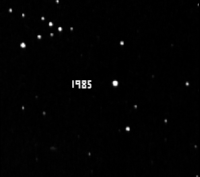
Photo from wikipedia
PURPOSE In the double-poling (DP) cross-country-skiing technique, propulsive forces are transferred solely through the poles. The aim of the current study was to investigate how pole length influences DP performance,… Click to show full abstract
PURPOSE In the double-poling (DP) cross-country-skiing technique, propulsive forces are transferred solely through the poles. The aim of the current study was to investigate how pole length influences DP performance, O2 cost, and kinematics during treadmill roller skiing. METHODS Nine male competitive cross-country skiers (24 ± 3 y, 180 ± 5 cm, 72 ± 5 kg, VO2max running 76 ± 6 mL · kg-1 · min-1) completed 2 identical test protocols using self-selected (84% ± 1% of body height) and long poles (self-selected + 7.5 cm; 88% ± 1% of body height) in a counterbalanced fashion. Each test protocol included a 5-min warm-up (2.5 m/s; 2.5°) and three 5-min submaximal sessions (3.0, 3.5, and 4.0 m/s; 2.5°) for assessment of O2 cost, followed by a selfpaced 1000-m time trial (~3 min, >5.0 m/s; 2.5°). Temporal patterns and kinematics were assessed using accelerometers and 2D video. RESULTS Long poles reduced 1000-m time (mean ± 90% confidence interval; -1.0% ± 0.7%, P = .054) and submaximal O2 cost (-2.7% ± 1.0%, P = .002) compared with self-selected poles. The center-of-mass (CoM) vertical range of displacement tended to be smaller for long than for self-selected poles (23.3 ± 3.0 vs 24.3 ± 3.0 cm, P = .07). Cycle and reposition time did not differ between pole lengths at any speeds tested, whereas poling time tended to be shorter for self-selected than for long poles at the lower speeds (≤3.5 m/s, P ≤ .10) but not at the higher speeds (≥4.0 m/s, P ≥ .23). CONCLUSIONS DP 1000-m time, submaximal O2 cost, and CoM vertical range of displacement were reduced in competitive cross-country skiers using poles 7.5 cm longer than self-selected ones.
Journal Title: International journal of sports physiology and performance
Year Published: 2017
Link to full text (if available)
Share on Social Media: Sign Up to like & get
recommendations!